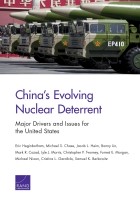| 来源类型 | Research Reports
|
| 规范类型 | 报告
|
| DOI | https://doi.org/10.7249/RR1628
|
| ISBN | 9780833096463
|
| 来源ID | RR-1628-AF
|
| China's Evolving Nuclear Deterrent: Major Drivers and Issues for the United States |
| Eric Heginbotham; Michael S. Chase; Jacob Heim; Bonny Lin; Mark R. Cozad; Lyle J. Morris; Christopher P. Twomey; Forrest E. Morgan; Michael Nixon; Cristina L. Garafola; et al.
|
| 发表日期 | 2017
|
| 出版年 | 2017
|
| 页码 | 212
|
| 语种 | 英语
|
| 结论 |
China's Approach to Nuclear Deterrence Has Been Broadly Consistent Since Its First Nuclear Test in 1964- China has, however, recently accelerated nuclear force building and modernization.
Chinese Nuclear Strategists Still Key Primarily on Nuclear Developments in the United States- Strategists are especially concerned about the development of U.S. missile defenses and conventional prompt global strike capabilities.
- But planners are also concerned about the growth of nuclear inventories in Asia and the complex nuclear dynamics emerging there.
- Some strategists say privately that China might not accept a push from India for nuclear parity, should New Delhi embark on such a course.
Bureaucratic Processes and Politics Are Likely to Affect the Development of Chinese Nuclear Forces and Thinking- Civilian leaders are reportedly less involved than they once were in the details of decisionmaking about nuclear research, development, and production.
- The nuclear constituency within the PLA is also gaining increased status and voice.
- There is no firewall between China's conventional and nuclear missile forces, and technologies and practices developed for the former are already being applied to the nuclear forces.
- In the future, this may give China some limited counterforce capability.
China Is Likely to Increase Emphasis on Nuclear Deterrence and Nuclear Forces in the Coming Years- Although unlikely to change formal policy formulations, China may adjust its definitions of key terms or add caveats.
- It may, for example, hedge its language on no-first-use to include a conventional attack on its nuclear forces as "first use," thus permitting a nuclear response.
|
| 摘要 |
- The United States and China should deepen their dialogue on strategic issues to better understand where restraint might have the greatest positive impact.
- The United States should limit national missile defense to a scale commensurate with the its stated purpose, defense against attack by rogue regimes. Missile defenses are one of the primary drivers of Chinese nuclear force building.
- China, for its part, should work toward visibly separating its conventional and nuclear missile force elements to reduce the possibility of confusion in the event of a conflict.
- China should also minimize the MIRVing of missiles, especially missiles that might be vulnerable to preemptive attack. Decades of arms control experience suggest that MIRVs can, under some circumstances, diminish crisis stability by increasing the incentives for both sides to strike first.
- U.S. leaders should take steps to fortify the credibility of extended deterrence. As Chinese capabilities improve, some regional states, especially Japan and South Korea, may request more than purely rhetorical reassurance. They may also seek the redeployment of U.S. nuclear weapons in Asia, and Washington will want to consider how far in this direction it is willing to go.
|
| 主题 | Ballistic Missiles
; China
; India
; Japan
; Missile Defense
; Nuclear Deterrence
; Nuclear Disarmament
; Russia
; United States
|
| URL | https://www.rand.org/pubs/research_reports/RR1628.html
|
| 来源智库 | RAND Corporation (United States)
|
| 引用统计 |
|
| 资源类型 | 智库出版物
|
| 条目标识符 | http://119.78.100.153/handle/2XGU8XDN/108694
|
推荐引用方式
GB/T 7714 |
Eric Heginbotham,Michael S. Chase,Jacob Heim,et al. China's Evolving Nuclear Deterrent: Major Drivers and Issues for the United States. 2017.
|
|
文件名:
|
x1549655274746.jpg
|
|
格式:
|
JPEG
|

|
文件名:
|
RAND_RR1628.pdf
|
|
格式:
|
Adobe PDF
|
除非特别说明,本系统中所有内容都受版权保护,并保留所有权利。